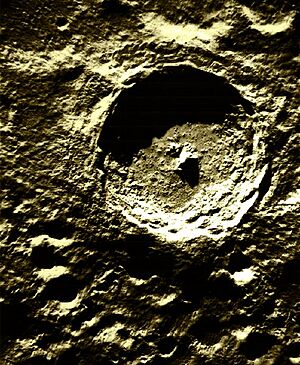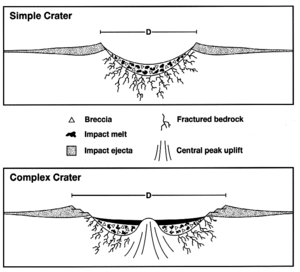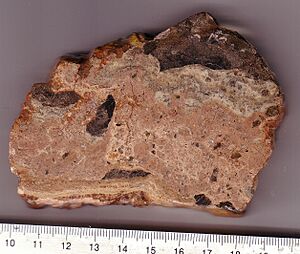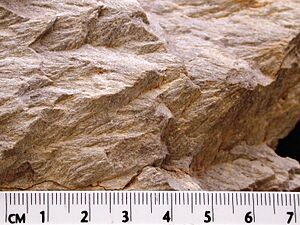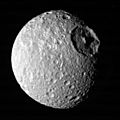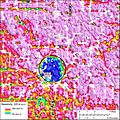Impact crater facts for kids
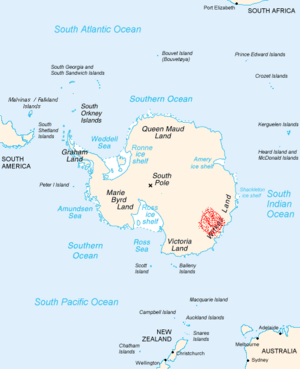
Impact craters are giant bowl-shaped holes. They are made when space rocks, like meteorites or comets, crash into planets or moons. These crashes leave a mark on the surface of solid objects in space. Scientists have a special way to study and record these craters.
Contents
Biggest Craters on Earth
The Earth has many impact craters. However, because of weather and the movement of the Earth's surface (plate tectonics), many old craters get worn away or buried. This is why the Moon has so many more visible craters than Earth. It shows that Earth was also hit by many space rocks a long time ago. This time is called the Late Heavy Bombardment.
Here are the five largest confirmed impact craters on Earth:
- Vredefort crater, South Africa: This crater is about 160 kilometers (100 miles) wide. It formed about 2,023 million years ago.
- Chicxulub crater, Mexico: This one is about 150 kilometers (93 miles) wide. It formed 65 million years ago. Many scientists think this impact caused the extinction of the dinosaurs.
- Sudbury Basin, Ontario, Canada: This crater is about 130 kilometers (81 miles) wide. It formed 1,850 million years ago.
- Popigai crater, Russia: This crater is about 90 kilometers (56 miles) wide. It formed 35.7 million years ago.
- Acraman crater, South Australia: This crater is also about 90 kilometers (56 miles) wide. It formed around 590 million years ago.
- Manicouagan crater, Quebec, Canada: This crater is about 70 kilometers (43 miles) wide. It formed 214 million years ago.
Possible Huge Craters
Scientists are still studying some other very large areas. They might be impact craters, but it's not yet certain.
- Australian impact structure: This huge area in the Northern Territory, Australia, has multiple rings. It could be up to 600 kilometers (370 miles) wide. It might have formed 545 million years ago.
- Shiva crater, Indian Ocean: This area is west of India. It's about 600 kilometers (370 miles) long and 400 kilometers (250 miles) wide. It might have formed 65 million years ago, around the same time as the Chicxulub crater.
- Wilkes Land crater, Antarctica: This possible crater is about 485 kilometers (300 miles) wide. It might have formed between 250 and 500 million years ago.
Biggest Craters in Our Solar System
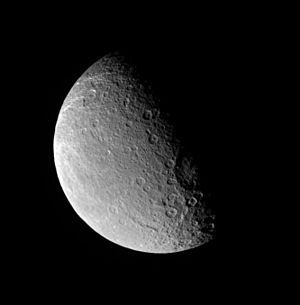
Here are some of the largest known craters on other planets and moons:
- North Polar Basin (or Borealis Basin) – on Mars. This is the biggest, with a diameter of 10,600 kilometers (6,600 miles). But some scientists still debate if it's an impact crater.
- South Pole–Aitken basin – on the Moon. This huge crater is 2,500 kilometers (1,550 miles) wide.
- Hellas Basin – on Mars. This crater is 2,100 kilometers (1,300 miles) wide.
- Caloris Basin – on Mercury. This crater is 1,550 kilometers (960 miles) wide.
- Imbrium Basin – on the Moon. This crater is 1,100 kilometers (680 miles) wide.
How to Identify Impact Craters
Scientists look for special clues to confirm if a hole is an impact crater. The most important clue is finding rocks that have been changed by the extreme shock of an impact. These changes can include:
- Shattered Rock: Underneath the crater floor, there's often a layer of broken and mixed-up rock. This layer is called a 'breccia lens'.
- Shatter Cones: These are cone-shaped marks in rocks. They look like stacked ice cream cones. They form when a powerful shockwave passes through the rock.
- Melted Rocks: The huge energy from an impact can melt rocks. You might find glassy bits of melted rock or other high-temperature rock types. These rocks can also have tiny amounts of rare elements, like nickel or iridium, which are common in meteorites.
- Changed Minerals: Under a microscope, scientists can see tiny changes in the crystals of minerals like quartz. The extreme pressure from an impact can even create new, super-hard materials, like tiny diamonds from carbon.
Images for kids
-
Eugene Shoemaker was a pioneer in studying impact craters. Here he is looking at meteorites under a microscope.
-
These are nested craters on Mars. They might have formed because the ground had layers of different strengths.
-
Herschel Crater on Saturn's moon Mimas. It's so big it makes the moon look like the Death Star!
-
This is the multi-ringed impact basin called Valhalla on Jupiter's moon Callisto.
-
This is an aerial map of the Decorah crater from the USGS.
-
Meteor Crater in Arizona, USA, was the first impact crater on Earth to be officially confirmed.
-
Shoemaker Crater in Western Australia was named after Gene Shoemaker.
-
Balanchine crater inside the Caloris Basin on Mercury. This photo was taken by the MESSENGER spacecraft in 2011.
See also
 In Spanish: Cráter de impacto para niños
In Spanish: Cráter de impacto para niños


